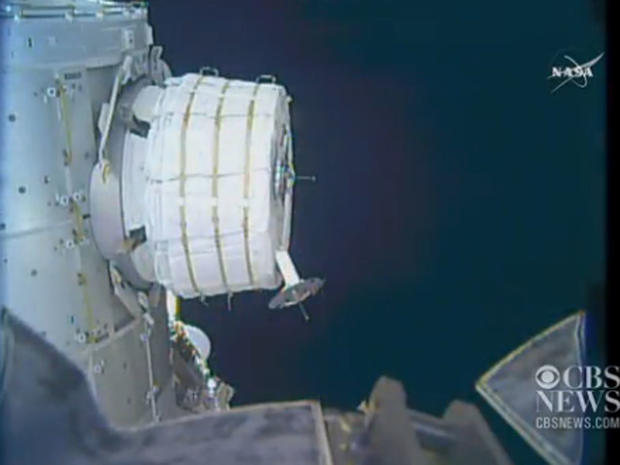NASA to try again on BEAM inflatable space station module
Engineers will deflate and then attempt to repressurize an experimental expandable crew module attached to the International Space Station early Saturday in hopes of freeing up a jam of some sort that prevented full inflation during an initial attempt Thursday, NASA managers said Friday.
The Bigelow Expandable Crew Activity Module, or BEAM, was launched to the station in a compressed state, with internal bulkheads bolted together and straps holding the compartment's reinforced fabric hull material in place.
The module was attached to the station's Tranquility module in April and engineers attempted to inflate the BEAM early Thursday. The restraining straps were released, the bolt holding the fore and aft bulkheads together was removed and air was released from internal tanks.
Pre-flight models predicted the pressure would go up and then drop as the compartment expanded and its internal volume increased. More air would cause the pressure to climb again, followed by a decrease as the module continued its expansion.
But during Thursday's attempt to inflate the BEAM, the pressure-volume ratio did not match predictions and the expansion halted after a modest increase in volume. NASA managers then opted to stand down while engineers carried out an engineering review.
Friday afternoon, mission managers said they planned to make a second attempt Saturday by first depressurizing the module, allowing its fabric walls to relax. Then they could press ahead with re-inflation, using higher pressure if needed. Engineers were still evaluating how to manage the pressurization process.
"What we're expecting to see out of that is a relaxation of the structure inside of BEAM, the fabric structures, and then that will allow us to ... walk back through the repressuzation sequence again," said Jason Crusan, director of NASA's advanced exploration systems.
"We believe this depressurization-to-pressurization cycle will allow relaxation in those forces and the fabric to shift around."
He said engineers believe more pressure will be needed, possibly because friction and other forces acting on the reinforced fabric are greater than predicted by pre-launch models.
"We want to ensure whenever we have an expansion event we don't impart any significant forces into the space station itself," he said. "Whenever it does expand out, we expect it to be somewhat gradual with a couple of energetic events as it kind of goes through its unfurling process.
NASA wants to make sure "that at no time do we impart loads," Crusan said. Flight controllers could have increased the pressure Thursday but opted to stand down to evaluate the models and to determine how best to manage the pressure.
Kenny Todd, space station operations and integration manager at the Johnson Space Center, said engineers expected a certain level of growing pains with untried hardware like the BEAM.
"It doesn't surprise me a great deal that we ended up here," he said. "These guys have a good plan for how they deploy these modules, it just happens to be the first one we've done on station and we added a pretty fair amount of conservatism into the way they deploy. So not a huge surprise."
He said the top-level priority was ensuring the safety of the space station and it's crew while coming up with a viable plan to get the BEAM module inflated. He said the ongoing work to expand the compartment would have a minimal impact on crew activity through the weekend.
But if the module is not inflated by the start of the week, it likely will be deflated again to eliminate any threat of unexpected behavior during upcoming, already planned work with the lab's robot arm.
Robert Bigelow, founder of Bigelow Aerospace, believes expandable modules offer the biggest bang for the buck when it comes to developing space habitats for use in low-Earth orbit, in the vicinity of the moon or on long-duration flights to Mars and elsewhere in the solar system.
Expandable modules offer a significant advantage over traditional solid-body compartments, taking up much less room atop a launch vehicle and allowing much roomier, lighter-weight modules to be launched than could otherwise be accommodated atop current rockets.
While Bigelow launched two small modules aboard Russian rockets, BEAM is the first such test with NASA, which is exploring a variety of options for deep space exploration. The objectives of the test are to simply inflate the module and then closely monitor its behavior over the next two years.
While BEAM is a relatively small module with a maximum volume of about 565 cubic feet, Bigelow hopes to launch a 12,000-cubic-foot module by around 2020.

